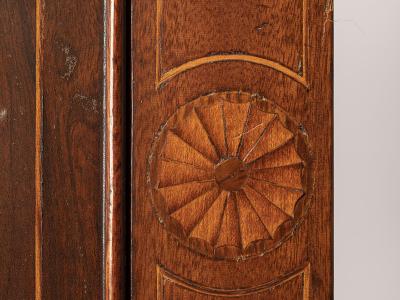Sideboard
Wilmington, Delaware
1805-1815
Maker
George Whitelock (1780-1833)
Measurements
40 1/4 in x 68 1/4 in x 24 3/4 in
Materials
Mahogany, light wood inlays and stringing; tulip poplar (drawer sides and bottoms), white pine (drawer fronts, door laminations, interior structure)
Credit Line
On loan from Winterthur
Accession Number
1996.18
Inscription
Labels of the maker pasted inside each central cupboard door read: “GEORGE WHITELOCK, / CABINET and CHAIR-MAKER, / Next door above the Town-Hall, Market-Street, Wilmington, / Respectfully informs his friends and the public, that he carries on the above busi- / nesses in all their various branches. As he is determined to employ only the best / workmen, and make use of the best materials, he has no doubt of giving satisfaction / to those who may favor him with their custom. / He intends keeping a stock of ready made furnishings on hand, so that per- / sons wishing articles in his line may be supplied on the shortest notice.”
Condition Notes
The present brasses are at least the third set; the oval backplates are slightly smaller than an earlier imprint. Evidence suggests the original brasses had a single post with a round backplate. Centered pulls once on the cupboard doors were probably not original. The top has split along the grain. Four holes for screws to resecure the top in each end are poorly filled. The present finish has lost clarity and obscures highly figured veneers.
Provenance
Ex coll. Mrs. William Watson Harrington of Dover, Delaware.
Comments
This six-legged sideboard with a bowed center, bears two printed labels of George Whitelock (fig. 67). It is one of two sideboard forms he is known to have made, the other having four legs and a “kidney-shaped” carcass with rounded front corners and a curved recessed center. Whitelock was a leading cabinetmaker in Wilmington. He advertised his business on Market Street “Next door above the Town Hall” in the November 10, 1804, edition of the Wilmington newspaper The Museum of Delaware, indicating that he had established his own shop just three years after completing his apprenticeship (probably in Philadelphia).
This sideboard has the customary tier of drawers above cupboards. None are compartmentalized inside for such special. Belying the simple interior, the drawer and cupboard doors have a richly mottled mahogany veneer that must have contrasted beautifully with the other monochromatic mahogany, stringing, and inlays.
Bibliography
Dorman, Delaware Cabinetmakers, unnumbered plate.
Zimmerman, A Storied Past, 136-137.


